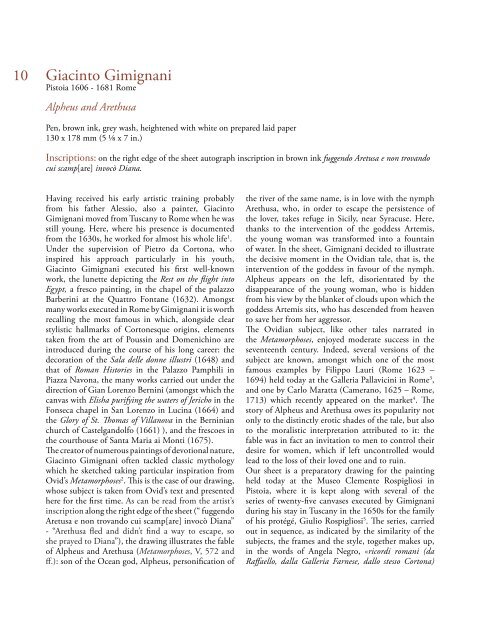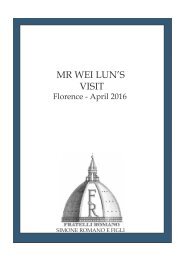A selection of master drawings 2016
- No tags were found...
Create successful ePaper yourself
Turn your PDF publications into a flip-book with our unique Google optimized e-Paper software.
10<br />
Giacinto Gimignani<br />
Pistoia 1606 - 1681 Rome<br />
Alpheus and Arethusa<br />
Pen, brown ink, grey wash, heightened with white on prepared laid paper<br />
130 x 178 mm (5 ⅛ x 7 in.)<br />
Inscriptions: on the right edge <strong>of</strong> the sheet autograph inscription in brown ink fuggendo Aretusa e non trovando<br />
cui scamp[are] invocò Diana.<br />
Having received his early artistic training probably<br />
from his father Alessio, also a painter, Giacinto<br />
Gimignani moved from Tuscany to Rome when he was<br />
still young. Here, where his presence is documented<br />
from the 1630s, he worked for almost his whole life 1 .<br />
Under the supervision <strong>of</strong> Pietro da Cortona, who<br />
inspired his approach particularly in his youth,<br />
Giacinto Gimignani executed his first well-known<br />
work, the lunette depicting the Rest on the flight into<br />
Egypt, a fresco painting, in the chapel <strong>of</strong> the palazzo<br />
Barberini at the Quattro Fontane (1632). Amongst<br />
many works executed in Rome by Gimignani it is worth<br />
recalling the most famous in which, alongside clear<br />
stylistic hallmarks <strong>of</strong> Cortonesque origins, elements<br />
taken from the art <strong>of</strong> Poussin and Domenichino are<br />
introduced during the course <strong>of</strong> his long career: the<br />
decoration <strong>of</strong> the Sala delle donne illustri (1648) and<br />
that <strong>of</strong> Roman Histories in the Palazzo Pamphili in<br />
Piazza Navona, the many works carried out under the<br />
direction <strong>of</strong> Gian Lorenzo Bernini (amongst which the<br />
canvas with Elisha purifying the waters <strong>of</strong> Jericho in the<br />
Fonseca chapel in San Lorenzo in Lucina (1664) and<br />
the Glory <strong>of</strong> St. Thomas <strong>of</strong> Villanova in the Berninian<br />
church <strong>of</strong> Castelgandolfo (1661) ), and the frescoes in<br />
the courthouse <strong>of</strong> Santa Maria ai Monti (1675).<br />
The creator <strong>of</strong> numerous paintings <strong>of</strong> devotional nature,<br />
Giacinto Gimignani <strong>of</strong>ten tackled classic mythology<br />
which he sketched taking particular inspiration from<br />
Ovid’s Metamorphoses 2 . This is the case <strong>of</strong> our drawing,<br />
whose subject is taken from Ovid’s text and presented<br />
here for the first time. As can be read from the artist’s<br />
inscription along the right edge <strong>of</strong> the sheet (“ fuggendo<br />
Aretusa e non trovando cui scamp[are] invocò Diana”<br />
- “Arethusa fled and didn’t find a way to escape, so<br />
she prayed to Diana”), the drawing illustrates the fable<br />
<strong>of</strong> Alpheus and Arethusa (Metamorphoses, V, 572 and<br />
ff.): son <strong>of</strong> the Ocean god, Alpheus, personification <strong>of</strong><br />
the river <strong>of</strong> the same name, is in love with the nymph<br />
Arethusa, who, in order to escape the persistence <strong>of</strong><br />
the lover, takes refuge in Sicily, near Syracuse. Here,<br />
thanks to the intervention <strong>of</strong> the goddess Artemis,<br />
the young woman was transformed into a fountain<br />
<strong>of</strong> water. In the sheet, Gimignani decided to illustrate<br />
the decisive moment in the Ovidian tale, that is, the<br />
intervention <strong>of</strong> the goddess in favour <strong>of</strong> the nymph.<br />
Alpheus appears on the left, disorientated by the<br />
disappearance <strong>of</strong> the young woman, who is hidden<br />
from his view by the blanket <strong>of</strong> clouds upon which the<br />
goddess Artemis sits, who has descended from heaven<br />
to save her from her aggressor.<br />
The Ovidian subject, like other tales narrated in<br />
the Metamorphoses, enjoyed moderate success in the<br />
seventeenth century. Indeed, several versions <strong>of</strong> the<br />
subject are known, amongst which one <strong>of</strong> the most<br />
famous examples by Filippo Lauri (Rome 1623 –<br />
1694) held today at the Galleria Pallavicini in Rome 3 ,<br />
and one by Carlo Maratta (Camerano, 1625 – Rome,<br />
1713) which recently appeared on the market 4 . The<br />
story <strong>of</strong> Alpheus and Arethusa owes its popularity not<br />
only to the distinctly erotic shades <strong>of</strong> the tale, but also<br />
to the moralistic interpretation attributed to it: the<br />
fable was in fact an invitation to men to control their<br />
desire for women, which if left uncontrolled would<br />
lead to the loss <strong>of</strong> their loved one and to ruin.<br />
Our sheet is a preparatory drawing for the painting<br />
held today at the Museo Clemente Rospigliosi in<br />
Pistoia, where it is kept along with several <strong>of</strong> the<br />
series <strong>of</strong> twenty-five canvases executed by Gimignani<br />
during his stay in Tuscany in the 1650s for the family<br />
<strong>of</strong> his protégé, Giulio Rospigliosi 5 . The series, carried<br />
out in sequence, as indicated by the similarity <strong>of</strong> the<br />
subjects, the frames and the style, together makes up,<br />
in the words <strong>of</strong> Angela Negro, «ricordi romani (da<br />
Raffaello, dalla Galleria Farnese, dallo stesso Cortona)





